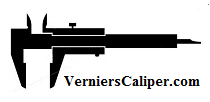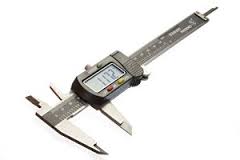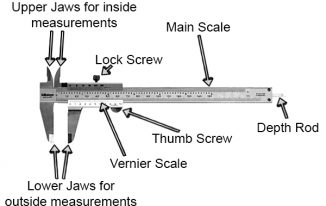It is a widely accepted statement that the best way to learn something is to do it yourself. This is true in most cases from driving a car, to building a robot. There is a point where reading about it ends and practical experience is the best way to make sure whether you have understood the theory or not. In many cases doing practicals may even help you understand some things which weren’t clear to you while reading. This is the reason why practical work is extremely important in all fields.
In previous articles we have explained the workings and principles of vernier calipers and this article will focus on helping you use a real caliper and taking measurements of different objects yourself.
Here are a few exercises for students to carry out:
1. Measure the Length of an Object
Before starting the measurement slide the moving scale using your thumb to check if it is moving freely. If the movement seems restricted check if the locking screw is engaged. Disengage the locking screw and then check movement again. To measure length hold the object firmly between the calipers jaws from end to end. When the object is in place take the reading from the scale as discussed previously.
2. Measure the Outer Diameter of a Cylinder
To measure the outer diameter of a cylinder, hold the cylinder between the large jaws of the caliper firmly. To get an accurate reading make sure the axis of the cylinder is perpendicular to the jaws. Placing the cylinder parallel to the jaws can cause the cylinder to move off center resulting in an inaccurate measurement.
3. Measure the Inner Diameter of a Cylinder
To measure the inner diameter of a cylinder, slide open the moving scale of the caliper. Place the upper , smaller jaws in the cavity of the cylinder and open the jaws till their surfaces come in contact with the inner walls of the cylinder. Take the measurement as usual.
4. Find out the Volume Of A Cylinder
Once you have completed the initial measurements, use your skills to find the volume of a cylinder. To do this measure the length and diameter of the cylinder as discussed previously. Then find out the radius by dividing the value by 2. Next use your measurement in the formula for the volume i.e:
Volume = πr^2h
5. Find out the Volume of a Sphere
The Volume of a Sphere can be measured through a similar process. First measure the diameter of the sphere. Make sure to take several readings and take an average of the values. Divide by 2 to find out radius. Us the radius in the formula:
V = 4/3 π r^3
6. Measure the Depth of a Hole:
The Vernier caliper has another function which may not be commonly known by students. The depth of a hole can be measured using the depth rod which slides out from the far end of the caliper as the jaws are moved. Place the caliper vertically over the hole such that the surface rests on top of the hole. Then slide the jaws open till the depth rod touches the bottom of the hole and take the reading.
To further test your knowledge regarding vernier calipers and the required methods we will provide a few viva questions which you can try to answer to find out how much you know about the subjects and learn about the things you don’t know.
Q1 What is Vernier Constant?
Q2 What is the sliding rod used for?
Q3 What type of measurements can be made using a vernier caliper?
Q4 Which one has the least accuracy among metre rule, micrometer and vernier caliper?
Q5 What is the formula for vernier constant?
Q6 Why is a sliding caliper called vernier caliper?
Q7 What is meant by zero error?
Try answering these questions by yourself first. Note down your answers and if you don’t know anything then research it by reading our previous articles or any other source.
It is important to practice as many readings and measurements as you can to be able to perfect your learning and skills. Worksheets like this are a good way to start. Look at the examples to refresh your learning and then attempt the questions that are given. Then look at the answers and compare them to yours to find out where you stand.


